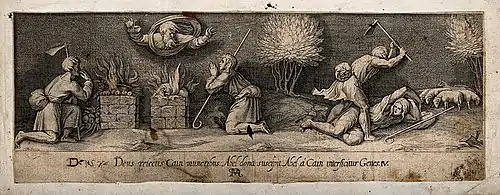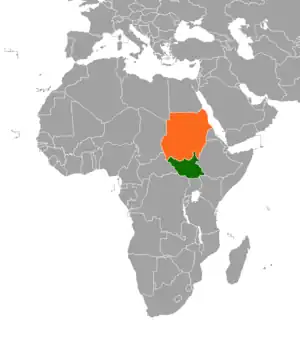Nomadic conflict
Nomadic conflict, also called farmer–herder conflict, is a type of environmental conflict where farming and herding communities overlap and has been used to refer to fighting among herding communities or fighting between herding and farming communities. This is sometimes referred to as conflict involving “pastoralists” or “nomadic” people and “agriculturalists” or “settled” people. The conflicts usually arise from destruction of crops by livestock and is exacerbated during times when water and lands to graze are scarce.[4]

Background
There are several hundred million pastoralists worldwide and Africa contains about 268 million pastoralists, over a quarter of its population, who live on about 43 percent of the continent’s land mass.[5]
Commercial displacement
Displacement of local communities to make way for commercial farms or mining activities has put pressure on grazing areas, exacerbating conflict.[5]
Climate change and land degradation
Desertification in the Sahel, where much of the present-day conflicts between herders and farmers takes place, is expanding southward by about 1400 square miles a year. Climate change has apparently exacerbated land degradation, which leads to more competition over grazing areas.[5]
History
Malti Malik summarises relationships and inter-dependencies between sheep-herders and sedentary farmers in Mari, a city-state on the Euphrates (in present-day Syria) which flourished between 2900 and 1759 BCE. The "nomadic groups included the Akkadians, Amorites, Assyrians and Aramaeans. [...] Some of them gained much power and succeeded in establishing their own rule. For example, the kings of Mari were Amorites." Interactions included trade and employment (as harvest workers or hired soldiers) as well as "robbing and plundering".[6]
Similarly, in the 13th century CE nomadic Mongols subjugated many of the agriculture-based states of Eurasia and founded the Mongol Empire.
Examples
Cameroon
More than 30,000 people in northern Cameroon fled to Chad after ethnic clashes over access to water between Musgum fishermen and ethnic Arab Choa herders in December 2021.[7][8]
Central African Republic
In the Central African Republic Civil War, a large portion of the fighting was between rebel groups known as ex-Séléka and rebel groups known as anti-balaka. While the ex-Séléka consisted of those who were largely Muslim and the anti-balaka consisted of those who were largely Christian and animist, an added dimension of the conflict was that ex-Séléka consisted of those from nomadic groups, such as the Fulani, Gula and Runga, and the anti-balaka consisted of those from agriculturalist groups.[9]
Congo, Democratic Republic of
Ethnic conflict in Kivu has often involved the Congolese Tutsis known as Banyamulenge, a cattle herding group that largely migrated from Rwanda in the 19th century and are often derided as outsiders. They are pitted against other ethnic groups who consider themselves indigenous. Militias drawn from the Bembe, Bafuliru and Banyindu have attacked and stolen cattle from the Banyamulenge.[10]
Kenya
Nigeria
Herder–farmer conflicts in Nigeria are a series of disputes over arable land resources across Nigeria between the mostly-Muslim Fulani herders and the mostly-Christian non-Fulani farmers. The conflicts have been especially prominent in the Middle Belt (North Central) since the return of democracy in 1999. More recently, they have deteriorated into attacks on farmers by Fulani herdsmen.
Attacks have also taken place in Northwestern Nigeria against farmers who are mainly Hausa, who are almost entirely Muslim. Many Fulani communities, who are usually farmers, have also been attacked and raided by Fulani bandits and other militias.[11] Despite the conflict fundamentally being a land-use conflict between farmers and herders across Nigeria's Middle Belt, it has taken on dangerous religious and ethnic dimensions mostly because most of the farmers are Christians of various ethnicities while most of the herders are Muslim Fulani who make up about 90% of the country's pastoralists.[12] Thousands of people have died since the attacks began. Sedentary farming in rural communities are often target of attacks because of their vulnerability. There are fears that the conflict will spread to other West African countries, but that has often been downplayed by governments in the region. Attacks on herders have also led them to retaliating by attacking other communities.[13][14][15]
The conflict has been labeled a genocide of Christians by several Christian and Nigerian sources.[16][17][18][19][20]Sudan and South Sudan

shown within Africa
Sudanese nomadic conflicts are non-state conflicts between rival nomadic tribes taking place in the territory of Sudan and, since 2011, South Sudan.[21] Conflict between nomadic tribes in Sudan is common, with fights breaking out over scarce resources, including grazing land, cattle and drinking water. Some of the tribes involved in these clashes have been the Messiria, Maalia, Rizeigat and Bani Hussein Arabic tribes inhabiting Darfur and West Kordofan, and the Dinka, Nuer and Murle African ethnic groups inhabiting South Sudan. Conflicts have been fueled by other major wars taking place in the same regions, in particular the Second Sudanese Civil War, the War in Darfur and the Sudanese conflict in South Kordofan and Blue Nile.
Over the years, clashes between rival ethnic militias have resulted in a large number of casualties and displaced hundreds of thousands of people.[22] In recent years, particularly violent clashes broke out in 1993 between Jikany Nuer and Lou Nuer in Upper Nile, in 2009-2012 between Lou Nuer and Murle in Jonglei and in 2013-2014 between Maalia, Rizeigat, Messiria, Salamat and Bani Hussein in Darfur and West Kordofan.[23]Nomadic conflict in Sudan has been a part of the Second Sudanese Civil War, the War in Darfur and the Sudanese conflict in South Kordofan and Blue Nile and has been a feature in ethnic violence in South Sudan.
References
- Schnurer, Eric (3 August 2017). "The Age-Old Urban-Rural Conflict". U.S. News & World Report.
- "Cain & Abel". World History Encyclopedia.
- "Cain and Abel's clash may reflect ancient Bronze Age rivalries". Culture. April 10, 2019.
- "Solutions to Farmer-Pastoralist Conflicts". Relief Web. 8 July 2011. Retrieved 27 June 2021.
- "Farmer-Herder Conflicts on the Rise in Africa". Human Rights Watch. 6 August 2018. Retrieved 30 June 2021.
- Malik, Malti (2016). "Early Cities: Iraq, 3000 BC (Writing and City Life)". History of the World (reprint ed.). New Delhi: New Saraswati House India Pvt Ltd. p. 56. ISBN 9789350419380. Retrieved 24 April 2023.
- "Thousands flee northern Cameroon after deadly intercommunal clashes". France 24. 10 December 2021.
- "Northern Cameroon bears brunt of inter-ethnic clashes, 22 dead, 30 injured". Africanews. 14 December 2021.
- "Displaced and forgotten in Central African Republic". Al Jazeera. Archived from the original on 15 February 2017. Retrieved 27 June 2021.
- "In eastern Congo, a local conflict flares as regional tensions rise". The New Humanitarian. 28 October 2019. Retrieved 12 November 2019.
- Salkida, Ahmad (2020-06-13). "Fulani: Villain And Victim Of Militia Attacks?". HumAngle. Retrieved 2023-05-12.
- "Stopping Nigeria's Spiralling Farmer-Herder Violence". International Crisis Group. 24 December 2020. Retrieved 26 July 2018.
- Ilo, Udo Jude; Jonathan-Ichaver, Ier; Adamolekun, 'Yemi (2019-01-24). "The Deadliest Conflict You've Never Heard of". Foreign Affairs: America and the World. ISSN 0015-7120. Retrieved 2020-04-18.
- "Herdsmen and Farmers Conflict in Nigeria: A Threat to Peacebuilding and Human Security in West Africa | Africa Up Close". Retrieved 2020-04-18.
- "Nigeria school abductions sparked by cattle feuds, not extremism, officials say". Reuters. 24 December 2020. Retrieved 24 December 2020.
- "Is Genocide Happening In Nigeria As The World Turns A Blind Eye?". Forbes.
- "Genocide Emergency: Nigeria". 23 September 2020.
- "The Mass Murder of Nigerian Christians". December 2020.
- "Why the West Ignores the Nigerian Genocide". Newsweek. 21 June 2021.
- "Stop the Christian Genocide in Nigeria". NCR. February 26, 2020.
- "UCDP Conflict Encyclopedia: Sudan: Non-state conflicts". Uppsala Conflict Data Program. Archived from the original on 22 March 2016. Retrieved 20 January 2015.
- "UCDP Non-State Conflict Dataset". Uppsala Conflict Data Program. Archived from the original on 22 January 2015. Retrieved 20 January 2015.
- "Inter-communal Conflict in Sudan". Armed Conflict Location & Event Data Project. 28 January 2015. Archived from the original on 7 February 2015. Retrieved 28 January 2015.